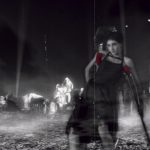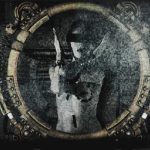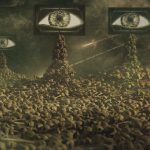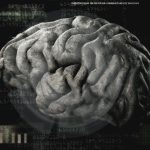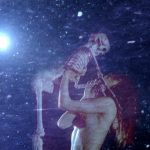His Electric Self Anthology is a series of videos all commented by musical passages realized by him. The works want to suggest a wish to enter directly inside a sort of electronic unconscious, of the cavern of shades contaminated by the new technologies, where live ghosts of images resurface, archetypical forms, but also “unexpected” clichés of the world of Internet, stereotyped characters, models, figures that float in the sea of the Net and that we look for and we upload on our computer without, for the most part, knowing the why. The entry in the world of the electronic unconscious – explains Alessandro Amaducci – is a dark trip, dense of wounds, where female characters are met, bodies that embody somehow some obsessive themes, as the life, the death, the desire, the voyeurism, the transformation of the world in a show and the stainless fascinating power of the human form, of the body meant to an esoteric, symbolic place. To enter the electronic unconscious also means to rediscover our own childish shade, that moment in which the dimension of the death and life are confused, and with which can be played also in a cruel way, in which the beauty and the monstrosity can cohabit, where the fear is necessary because heralding of emotions. In the technological unconscious, we dance gladly always with Death.
Not with a Bang (2008) | Alessandro Amaducci | IT | 05:12 min
“This is the way the world ends.
Not with a bang but a whimper.”
These are the final verses of the well-known poem by Thomas Stearns Eliot, “The Hollow Men”. The end of the world won’t be something very spectacular, but a slow fade in black. Maybe we are living in that fade, and we don’t know. In this video, there are a lot of bangs and explosions, but they are quite digital, artificial. They don’t really destroy anything, because everything is already destroyed. Images destroying other images. The central idea was the making of a sort of theatre of memory made by images, directed by a “black widow” with two crutches: a fragile and very strong female figure. The crutches and their symbolical meaning are a reference to Salvador Dali’s paintings. She is the conductor of an orchestra of destruction. Maybe the ghost of a victim was taking her revenge, maybe the vintage heroin of a vintage videogame.
Future(ism) (2013) | Alessandro Amaducci | IT | 02:30 min
The video is freely inspired by the publication in 1909, on the first page of the French newspaper Le Figaro, of the Futurist Manifesto by Filippo Tommaso Marinetti. The video depicts how the digital image is able to build different ideas of the future, taken from various imageries. The video was commissioned by Magmart International Videoart Festival for the itinerant exhibition 100×100=900 (100 Video artists to Tell a Century), http://www.magmart.it/900/. The task for the selected artists was to work on one randomly chosen year of the history of the Twentieth Century.
Electric Self (2006-16) | Alessandro Amaducci | IT | 04:00 min
A dancer in the balance between darkness and light. Creativity and unconsciousness: in the subtle edge between dreams and reality stand the chance to come into the world. In the digital age, computers can create languages and worlds, so maybe they have an idea of the world, maybe they make dreams. Inside the cave of the technological unconsciousness, there is the electric self: a world apart that produces images of the inner world.
Discussion on Death (2006-18) | Alessandro Amaducci | IT | 06:00 min
In the digital age, the idea of limit doesn’t exist anymore, and so vanishes the concept of death too. We think we can be forever young, or immortals. The bodies change and transform, the science promises new models of efficiency: the solution is a pill. In the labyrinth of mirrors in which we recreate constantly the image of ourselves, we give birth to ourselves: creatures already available to the final mutation. A trip around the identities of the self of digital images.
Fear of Me (2008-17) | Alessandro Amaducci | IT | 06:00 min
The fear of the body. The curiosity of the interior of ourselves is an atavist desire. But it brings us in unknown territories because entering in our bodies means also meet a sort of ultimate mirror, the definitive shadow of ourselves. So, the anatomical imagery recalls us that we are, definitively, mortals. But also that we can explore new ways of awareness, watching ourselves by an alternative point of view.
Black Data (2012) | Alessandro Amaducci | IT | 04:00 min
The oneiric world is the most fascinating mistake of the digital age. Meeting archetypical figures, the machine becomes a sort of techno-mother who brings to life dreams and nightmares. The androgyne is the blending of unconsciousness and technology. Black data on your computer.
In the Cave (of technology) (2013) | Alessandro Amaducci | IT | 05:38 min
Do computers dream? They do. We live in a cave full of technology, and we are surrounded by the shadows of the worlds we create, but now also technology is able to create worlds, to offer points of view of the world, and to change the look of the world. We want to be watched by technology, we want to watch inside the technology. So what happens when our imagery and our system of images collide with the technology’s imagery? An overflow of “models” and archetypes, but also something new: the union of dream and science, of natural and artificial, of past and future tenses.
I Am Your Database (2014) | Alessandro Amaducci | IT | 03:53 min
You have only one life. In the videogame of life, the final battle has begun, and the winner is already decided. Database of life, a database of death.
Post Rebis (2016) | Alessandro Amaducci | IT | 03:39 min
In a destroyed land someone or something is building a New Rebis made by flesh and technology.
Shedding (2010-18) | Alessandro Amaducci | IT | 07:00 min
The look of the science. Watching and being watched. The artificial and natural world look into each other. A lab with some scientists, and the body of a woman analyzed by strange machines. The scientists are checking the brain (the dream? The thoughts?) of this body, meeting the double of her, who’s dancing inside an amniotic ambient made by images. The experiment will give an unexpected result, the combination of science and dreams.
Pagan Inner (2010) | Alessandro Amaducci | IT | 06:30 min
A dance macabre celebrating the risk of life. Nothing more than the idea of the final limit makes ourselves conscious that we are living creatures. The “dance of the skeleton” is a very ancient image connected with the strong relationship between the concepts of life and death. The “dance macabre”, a woman dancing with a skeleton, is an archetypical image that goes deeper, figuring the fact that life itself is a constant duet with the death. By a romantic-gothic point of view, there’s nothing so macabre, it’s only a matter of awareness. So let’s dance with the death to celebrate the risk of life.
Curated by Maurizio Marco Tozzi
Maurizio Marco Tozzi is a curator of contemporary art. He has focused his research on the audiovisual language and the relationship between creativity and new technologies. He has a degree in Cinema and Image Electronics from the University of Pisa (Italy), and a Master in Net Art and Digital Cultures from the Fine Art Academy of Carrara (Italy). He is the founder and director of Over The Real – International Festival of Video Art (GAMC Lorenzo Viani – Viareggio), and he has curated exhibitions in galleries and museums. He regularly takes part in lectures and talks about contemporary art. His last essays are: Gianni Melotti, art/tapes/22 videotape production (Giunti publisher, 2017), The Italian Video Art (Danilo Montanari publisher, 2016), and Seamless Interaction with Works of Art published in Media Art Towards a New Definition of Arts in the Age of Technology (Gli Ori publisher, 2015).
Born in Turin (Italy) in 1967. He works as a teacher of video language and practice in DAMS, a Department of the University of Turin, Italy. Since 1989 he has produced experimental videos, documentaries, music videos, video installations, multimedia shows, video scenographies for dance performances.

